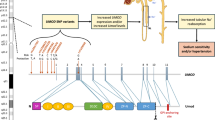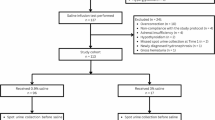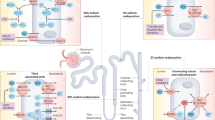Abstract
WHILE investigating the renal excretion of water and sodium by rats in response to intravenous infusion of isotonic saline1,2, it became desirable to consider some aspects of the renal tubular re-absorption of these substances3. We have attempted to do this by considering a model of the tubules based upon properties of a membrane the characteristics of which have already been studied. Some properties of frog skin have been described by Using and Zerahn4, and it seems that this membrane can act as a ‘sodium pump’, actively transferring sodium ions; the activity of the ‘sodium pump’ appearing as an e.m.f. of about 100 mV. across the membrane. The rate of water transfer may be regarded as dependent upon hydrostatic and osmotic pressure differences across the membrane and upon its permeability towater.
This is a preview of subscription content, access via your institution
Access options
Subscribe to this journal
Receive 51 print issues and online access
$199.00 per year
only $3.90 per issue
Buy this article
- Purchase on SpringerLink
- Instant access to full article PDF
Prices may be subject to local taxes which are calculated during checkout
Similar content being viewed by others
References
Cole, D. F., Acta Endocrin., 19, 397 (1955).
Cole, D. F., Quart. J. Exp. Physiol. (in the press).
Cole, D. F., and Meredith, J. F., Bull. Math. Biophys. (in the press).
Ussing, H. H., and Zerahn, K., Acta Physiol. Scand., 23, 110 (1951).
Sawyer, W. H., “The Hormonal Control of Water and Salt Electrolyte Metabolism in Vertebrates”, Mem. Soc. Endocrinol., No. 5, Pt. 2, Ed. I, Chester Jones and P. Eckstein, pp. 49 and 69 (Cambridge University Press, 1956).
Author information
Authors and Affiliations
Rights and permissions
About this article
Cite this article
COLE, D., MEREDITH, J. Possible Interaction of Anti-diuretic and Sodium-retaining Hormones in the Kidney. Nature 178, 1123 (1956). https://doi.org/10.1038/1781123a0
Issue date:
DOI: https://doi.org/10.1038/1781123a0



